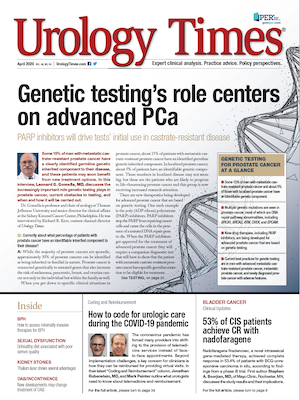Publication
Article
Urology Times Journal
Is MRI fusion Bx the new gold standard for diagnosing PCa?
Author(s):
“It hasn’t become the gold standard yet. There are still a lot of inter-reader reliability issues. The same MRI scans, read by different radiologists, may be read differently," says one urologist.
Urology Times reached out to three urologists (selected randomly) and asked them each the following question: Is MRI fusion Bx the new gold standard for diagnosing PCa?
“It hasn’t become the gold standard yet. There are still a lot of inter-reader reliability issues. The same MRI scans, read by different radiologists, may be read differently. That’s going to limit its broad application across the country as a whole and is a major issue.
Anecdotally, within our own practice we’ve seen that when a scan done in one facility needs to be translated for the fusion biopsy machine we utilize, we’ll get a different reading from the radiologist here than from the original radiologist. There’s a discrepancy between what the two radiologists see on the scan. That issue definitely needs to be worked out.
I expect some interesting data on that in the future. The PI-RADS system tries to standardize the readings, but there are still discrepancies between the different readers.
Working out the readability issue will make a difference. There will be patients who have a false-negative MRI but still have significant prostate cancer present. The data isn’t there yet that MRI fusion biopsy can be used as a rule-out test for someone with a very high suspicion of prostate cancer. It’s another data point as to whether someone needs a biopsy.
The gold standard is still a positive traditional biopsy, but that could evolve over the next few years.
The other issue is whether it gets broad acceptance from insurance companies. Some insurers approve it in the initial biopsy setting, but many do not. So that’s going to be the next point for broad applicability.
Still, I would say we’re definitely seeing an increased utilization of MRI for additional diagnosis of prostate cancer within our practice as a whole.”
Seth Strope, MD
St. Louis
Next:"I don’t think they’re necessary for everybody"“We don’t have MRI fusion biopsy available in our community, in our hospital, or in our office, so for an initial biopsy, we still do standard transrectal ultrasound biopsy in the office with ultrasound guidance. We may refer patients who need a second biopsy to a university center for MRI fusion for a second biopsy if they have persisting elevated PSA or other factors that are suspicious. It’s just not feasible for everybody to do MRI fusion yet. For the majority of urologists, it’s still not even commercially available.
Even if it were available, I’m not sure it would be our first choice yet. The yield is a little bit better, but our percentage yield of positive biopsies is pretty close to MRI fusion biopsies, at least in our practice. Our results differ by just 5% to 10%-not much.
I don’t think they’re necessary for everybody. As I said, we use them when we’re puzzled, when men have already had two or three biopsies, and we see them for consultations. In those situations, MRI fusion is a good next step.”
Robert Eisenberg, MD
Modesto, CA
Next:"I am still skeptical about MRI fusion because MRI quality varies so much nationwide"“That’s a great question. At our center, probably 80% of biopsies are done the traditional way with a transrectal ultrasound-guided approach.
Practice patterns in our area and insurance coverage usually dictate that the patient with an elevated PSA who needs a first-time biopsy is not able to get an MRI covered by insurance. That may change over the next couple years, but now most initial biopsies are done the standard way.
I am still skeptical about MRI fusion because MRI quality varies so much nationwide.
A regular biopsy certainly is more efficient, less expensive, and takes less time in the urologist’s office. Fusion biopsy generally takes about twice as long as a standard biopsy. Fusion biopsies could easily create issues of having enough providers, nurses, and rooms to do all biopsies in a fusion manner on every patient with an elevated PSA. It’s resource intensive and expensive.
We initiated an important program with our primary care doctors to do a better job identifying younger men with elevated PSA, high-risk men, such as African-American men, and men with a family history of prostate cancer. That’s increased the number of men who need biopsies at our center.
I’d rather focus on reaching underserved men and not be totally swept away by the MRI craze, especially since some recent data shows that results from initial MRI fusion biopsies can vary greatly, even in clearly high-grade cases.
The other thing is, no one just does fusion biopsy. Every single fusion biopsy is associated with a regular biopsy. Why do all the doctors advocating fusion biopsy do fusion plus regular biopsy in everybody?”
Judd Moul, MD
Durham, NC

Newsletter
Stay current with the latest urology news and practice-changing insights — sign up now for the essential updates every urologist needs.
























